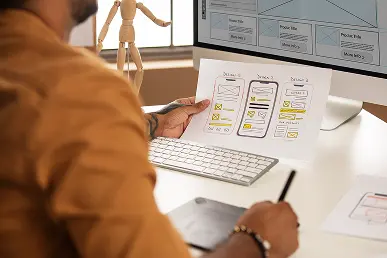Industry: Sports
Skills: JavaScript, Node JS, Golang, React JS, Python, Kotlin, MySQL, Mongo DB
Guaranteed reply within 12 hrs | 100% Secure. Zero Spam
With state-of-the-art technology and a team of highly-skilled and experienced professionals, we go above and beyond in terms of delivering top-notch UI and UX design services that captivate users and enhance their interactions with digital platforms. From wireframing & prototyping to web design and mobile app design, you name it, we deliver it with utmost care and perfection.
Weaving cutting-edge technologies and innovation with time-tested methodology, we create navigational product wireframes that outline the structure as well as layout, along with clickable product prototypes simulating the user experiences and functionality of your product.
Want to validate your ideas with top-notch MVP designs? At APPWRK, our specialized UI/UX design services for MVP are crafted to bring your vision to life with a perfect blend of aesthetics, functionality, and most of all user-centered design. From concept to launch, our high-quality MVP design ensures you hit the market fast.
As the premier user interface design company, we design user-friendly, aesthetically appealing, and interaction-rich web portals and web apps that offer seamless navigation and help you create a dominant online presence.
From in-depth UI/UX research and ideation to product prototyping to creating high-quality mobile app interfaces, our team of seasoned UI UX designers will help you with that while ensuring intuitive flows, clear visual hierarchy and interactive elements that improve usability.
Is your product’s user experience confusing, leading to frustrated users and increased abandonment rates? At APPWRK, we will assess your product design from top to bottom and fine-tune it to improve user experiences and boost engagement.
Leveraging 15 years of experience, we’ll examine your design system, smooth out inconsistencies and streamline workflows to save your team time and money.
At APPWRK, we create user-centered SaaS product designs that offer seamless experiences across devices as well as screen sizes, making your services more accessible and highlighting your product’s full potential.
Want to test your idea without spending a fortune on development? Turn your product idea into reality with our high-fidelity prototypes that look and feel like the real thing.
and many more...
At APPWRK, we go above and beyond in terms of designing exceptional UI/UX solutions that are customized for FMCG, SaaS, Fintech, Edtech, Healthcare, and more industries. Our user-centric solutions increase engagement as well as usability and fuel your business growth.

We craft intuitive UI/UX designs for healthcare platforms that prioritize accessibility, compliance, and ease of use—ensuring seamless interaction for both patients and professionals.

We specialize in UI/UX for SaaS products, creating scalable, user-centric designs that drive engagement, reduce churn, and enhance onboarding experiences.

We design compelling digital interfaces for FMCG brands that elevate brand experience, promote discovery, and drive rapid conversions across web and mobile platforms.

We design secure, conversion-driven UI/UX experiences for fintech products—ensuring compliance, clarity, and confidence in every transaction.

We create immersive UI/UX solutions for real estate platforms that simplify property discovery, showcase listings beautifully, and streamline user interactions.

We deliver high-converting ecommerce UI/UX designs with a focus on speed, clarity, and seamless product journeys—boosting both sales and retention.

We design engaging UI/UX for fitness platforms that motivate users, track progress seamlessly, and personalize workout and nutrition journeys.

We craft appetizing and easy-to-navigate UI/UX designs for restaurants that boost reservations, streamline ordering, and enhance customer loyalty.

We create high-energy, fan-focused UI/UX designs for sports platforms that amplify engagement, enable live interaction, and celebrate team spirit.

We design modern, intuitive UI/UX for educational platforms that enhance learning experiences, promote collaboration, and simplify content delivery.

We build UI/UX solutions for logistics that optimize shipment tracking, streamline operations, and provide full visibility across the supply chain.
Craft intuitive user interface design and captivating experiences tailored specifically to your brand with our top-notch UI/UX design services.
At APPWRK, we follow a systematic process to deliver a customized user experience with resourceful UI UX design and development solutions. From understanding your requirements to delivering the final solution, we go the extra mile in terms of delivering top-notch UI UX design services.
Your business is unique, and as such, so are your UI/UX requirements. From the first sales meeting, we dive deep into understanding your business, audience, industry as well as your goals and needs.
After properly understanding your needs and requirements, we create blueprints, mapping out user flows and interface elements to ensure a seamless experience.
Once the wireframes are created, our team moves on to designing the interface. They put in painstaking efforts in making the product both attractive and easy to use, creating a smooth and enjoyable experience for users.
Finally, we thoroughly test and refine the design, ensuring it meets user expectations and achieves your business objectives.

With a reputation in the market as the top UI & UX design company, we, at APPWRK, strategically craft visually appealing as well as functional digital experiences that’ll not only increase user engagement but will also turn your visitors into paying customers. By expertly combining user research with expertise in human-computer interaction, cognitive psychology and usability principles, we craft user-oriented, elegant UI UX to delight your users.

With a 100% success rate on Upwork, we are here to help you design experiences that leave a long-lasting impact.
More than money, we work to earn our client’s satisfactory responses.
Being the leading UI design service provider, we house a team of 20+ UI UX designers.
Our tech stack for UI & UX encompasses a wide array of top-of-the-line technologies. We are proficient in various UI/UX design tools including AI tools, so our clients can be sure they get functional as well as appealing interfaces designed within set time frames.





Deploy an expert team of UI UX designers who are fully committed to your project’s success. From the initial idea phase to execution, our experts ensure consistent, high-quality UI UX designs.

Extend your team with proficient UI UX designers who seamlessly integrate into your current workflows. Our UI UX designers will collaborate with your team, ensuring the on-time delivery of projects while driving business growth.

Partner with our team of UI UX designers dedicated to delivering your UI and UX designs on time and under budget. We guarantee outcomes aligned with your business’ specific requirements.
With a mission to not only meet but also exceed our clients’ expectations and demands, we go above and beyond in terms of providing services that are meticulously tailored to align with your distinct business requirements. At APPWRK, we blend innovation with user-centric functionality as well as state-of-the-art technology to create user interfaces that captivate and streamline user experiences.

Before we release the final design, we put it through a series of rigorous quality checks to make sure it lives up to the expectations and demands of our clients.

At APPWRK, we understand that every UI/UX design project is unique. This is the reason why we lay the foundation of your success with our exceptional project vision and strategic insights.

We, at APPWRK, distinguish ourselves through our commitment to cross-platform experience design, ensuring seamless interaction across multiple devices, be it smartphones, laptops, or tablets.

At APPWRK, our developers are skilled in developing advanced NLP solutions, including intelligent chatbots and virtual assistants, designed to enhance customer engagement and improve operational efficiency.

As a full-service UI/UX design company, we design digital experiences that are clear, useful, and most of all enjoyable, by focusing on how real people think, scroll, click and explore.
Whether you want to launch an MVP, optimize a SaaS product, or want to modernize an enterprise system, we will leave no stone unturned in terms of designing seamless, user-friendly experiences that’ll help you outshine your competitors. From early wireframing to full-scale UI/UX, we’ll craft intuitive flows that’ll boost engagement and feature adoption in no time.
Whether you want ongoing support, on-demand UI UX design services, or periodic updates, we’ll ensure that you have access to the right talent at the right time.
From basic even apps to scalable enterprise software for Fortune 500 companies, we have an excellent track record of creating intuitive, user-friendly, and appealing UI/UX design solutions.
Unlike many UI/UX design companies out there that hide their fees, we publish our fees upfront and guarantee that there will be no last-minute costs added to our user experience design services.
With a dedicated UI UX team, we work hard and try our best every time so that the work we do can meet the expectations of our clients as well as satisfy the standard we have set for ourselves.
With status reports and weekly meetings, we, at APPWRK, make sure you are never left in the dark when it comes to your UI UX design project’s progress.
Having designed UI UX for numerous brands for over a decade, our team, at APPWRK, has accumulated great expertise as well as experience that allows them to yield quality products that fit your requirements.
At APPWRK, we take pride in our top-notch customer support service, which naturally contributes to our high customer satisfaction and retention rates.
Industry: Sports
Skills: JavaScript, Node JS, Golang, React JS, Python, Kotlin, MySQL, Mongo DB
Industry: Automotive
Skills: Adobe, Figma, Prototyping
Industry: E-commerce
Skills: Adobe, Figma, Prototyping
Have any doubts? Our FAQ sections provide clear and detailed answers to help you understand every aspect of our UI/UX design process and services.






